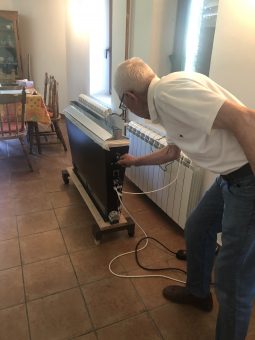
For some passers-by, Milivoj Pejin’s house in Sremska Kamenica is a seemingly ordinary family home that does not differ from its surroundings. More informed people are aware that this is not the case because the basic building material of this house is straw. The third group of people is we who have had the opportunity to go inside. Stepping inside Milivoj’s thatched walls, we felt as if we had entered the portal to the world of the unusual inventor Balthazar from the cartoon of the same name. There are a lot of similarities between him and our host, and you will conclude from the following lines which similarities are these.
Milivoj Pejin is a retired traffic engineer. He spends his leisure time perfecting several different inventions. He pro-tected five or six of them. However, due to the high cost of retaining that right on an annual basis, Milivoj is forced to give up patents one by one. He will not give up the one he has the most faith in, under no circumstances.
The device in question is a so-called electrical conductor, one of a kind apparatus for warming air by free circulation which is, according to its conceptual creator, entirely better than the competition in the market.
In focus:
“First of all, it’s better because no heating device has such a constructed heater. Three sheet heaters with individual power of 1 kW are installed between the perforated aluminium sheet metals. They draw electricity in cycles with lower hourly consumption, but still sufficient for the warmed-up heater to deliver more energy than the heaters used in cycles. It allows the application of two bimetallic thermostats that maintain the heater’s temperature between 160 and 200 degrees Celsius. With one heater it can deliver 153 kg/m3 per hour, and with three heaters in the same conditions less than 200. This device does not save but makes maximum use of the available electricity from the distribution, and electrical and mechanical design solution of the machine enables the delivery of power, more than the amount consumed,” our interviewee reveals, adding that the electric conductor weighs 6 kg.
“The parts cost around 35,000 dinars, and it takes approximately five hours to assemble them. If these activities were done industrially, the cost of production would be lower. However, given the effects generated by an electrical conductor compared to the existing devices, its sales price could be higher if financial mathematics were applied,”
Milivoj points out.
He did not forget the role of his friend Branko R. Babic in the creation of an innovative device. The two enthusiasts met ten years ago at a Tesla fest in Novi Sad. Milivoj then complained to Branko that he was unsuccessfully trying to develop a heating system that would be cheaper than a market offer. The friend offered him to use his contrivance
– perforated aluminium sheet metals, as a starting point. They are now the essence of not only the electrical conductor but also Milivoj’s versions of air condition without compressor, computer coolers and solar collectors.
Even though we were visiting the Pejin family during one hot June day, the inventor wanted to show us how the electrical conductor works, so we simulated optimal laboratory conditions in the basement of the house.
Equipped with a notebook, a pen and a temperature gauge, we closely monitored the performance of the apparatus. The inlet air temperature was 22 degrees Celsius, and the outlet air temperature was 160 degrees Celsius.

By recording the key values and incorporating them into the appropriate formulas, we calculated that in the given circumstances, work of an electrical conductor, with one heater on, would result in more than double energy savings. We have concluded that within 24 hours, the electrical conductor would only consume 18-kilowatt hours and deliver 40-kilowatt hours.
“That way a kilowatt-hour would cost half as much, no matter what EPS cost zone the household is in, which is a significant economic contribution,” Milivoj explains. He then flatteringly told us that in an hour, we had perfected our skills enough to carry out similar experiments independently.
In the end, the only question is whether, after reading our report from the slopes of Fruska Gora, the comparison we used in the introduction is clearer to you.
Prepared by: Jelena Kozbasic
This article was published in the new issue of Energy portal Magazine CLIMATE CHANGE, September – November 2019.



